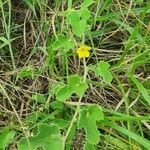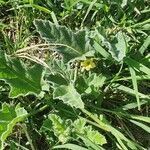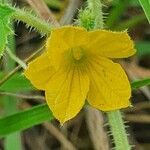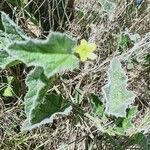Climber or trailer to 2 m.; stems hispid or scabrid with spreading or ± adpressed sometimes cinereous hairs; basal stems tough, light-barked, somewhat thickened, arising from a perennial rootstock.. Leaf-blade broadly ovate to suborbicular in outline, ± cordate or subtruncate at the base, sinuate-toothed, 10–94 mm. long, 10–82 mm. broad, unlobed or more usually palmately, often deeply, 3–5-lobed; shape of lobes various; petiole 6–87 mm. long, hairy like the stem.. Male flowers 1–6 on 3–25 mm. long pedicels; receptacle-tube green, 2.5–5 mm. long; lobes subulate, 1–2.5 mm. long; petals yellow, 5–7 mm. long, 2–3.5 mm. broad, united below.. Female flowers on 6–30 mm. long stalks; ovary ellipsoid, 4.5–15 mm. long, 2.5–5 mm. across, ± distinctly softly papillate, each papilla ending in a forward-pointing hyaline bristle; receptacle-tube 2.5–4 mm. long; lobes subulate, 1–3 mm. long; petals 5–8 mm. long, 2.5–3.5 mm. broad, united below.. Fruit on an 8–40 mm. long stalk, subglobose to ellipsoid, 16–63 mm. long, 15–33 mm. across, quite closely beset with 0.5–12 mm. long soft rather slender terete bristle-tipped aculei, otherwise usually glabrous, pale green with very obscure to markedly distinct darker longitudinal stripes, practically uniform yellow when ripe.. Seeds elliptic in outline, smooth, compressed, ± 5 × 2 × 1 mm.
More
A herb. It is a pumpkin family plant. It can lie along the ground or be climbing. The stems are slender. The tendrils are simple and short. It has a taproot. The leaves are oval or round and 2-4 cm long. They can have 3-5 lobes. Male and female flowers are separate. Male flowers occur in groups of 2 or 3 and female flowers occur singly. The fruit are oval and hairy. They have soft bristles. They have yellow and green stripes along them. They are 3-4 cm long by 2-3 cm wide. The seeds are pale. There are 2 subspecies.
Fruit somewhat resembling a gooseberry, with longitudinal coloured stripes.
A ground-trailer from a perennial base
It is a tropical plant. It grows between 3-2,400 m altitude. It can grow in stony, sand or clay soils. It can grow in alkaline soils. It is often over limestone material. It grows in areas with an annual rainfall of 400 mm. It can grow in arid places.
More
Semi-desert scrub; deciduous bushland and grassland; in tugs or on limestone slopes; dry Acacia bushland; open Acacia-Commiphora bushland and grassland; also in cultivated places from sea level to elevations of 2,010 metres.








